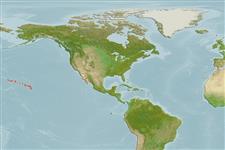Teleostei (teleosts) >
Blenniiformes (Blennies) >
Blenniidae (Combtooth blennies) > Blenniinae
Etymology: Plagiotremus: Greek, plagios = oblique + Greek, trema = hole (Ref. 45335).
Environment: milieu / climate zone / depth range / distribution range
Ecology
Marine; reef-associated; depth range 4 - 55 m (Ref. 58302). Tropical
Eastern Central Pacific: endemic to the Hawaiian Islands.
Size / Weight / Age
Maturity: Lm ? range ? - ? cm
Max length : 10.2 cm SL male/unsexed; (Ref. 3921)
Adults are benthic and benthopelagic in or over coral (Ref. 58302). They hover generally above the reef waiting for unwary prey. They feed on fishes. Oviparous. Eggs are demersal and adhesive (Ref. 205), and are attached to the substrate via a filamentous, adhesive pad or pedestal (Ref. 94114). Larvae are planktonic, often found in shallow, coastal waters (Ref. 94114). Difficult to rear in aquaria because they cannot easily be induced to accept ordinary fish food (Ref. 3921).
Life cycle and mating behavior
Maturity | Reproduction | Spawning | Eggs | Fecundity | Larvae
Oviparous, distinct pairing (Ref. 205).
Randall, J.E., 1985. Guide to Hawaiian reef fishes. Harrowood Books, Newtown Square, PA 19073, USA. 74 p. (Ref. 3921)
IUCN Red List Status (Ref. 130435: Version 2024-2)
Threat to humans
Harmless
Human uses
Fisheries: commercial; aquarium: commercial
Tools
Special reports
Download XML
Internet sources
Estimates based on models
Preferred temperature (Ref.
123201): 24.9 - 25.8, mean 25.3 °C (based on 38 cells).
Phylogenetic diversity index (Ref.
82804): PD
50 = 0.5005 [Uniqueness, from 0.5 = low to 2.0 = high].
Bayesian length-weight: a=0.00389 (0.00180 - 0.00842), b=3.12 (2.94 - 3.30), in cm total length, based on all LWR estimates for this body shape (Ref.
93245).
Trophic level (Ref.
69278): 4.2 ±0.73 se; based on food items.
Resilience (Ref.
120179): High, minimum population doubling time less than 15 months (Preliminary K or Fecundity.).
Fishing Vulnerability (Ref.
59153): Low vulnerability (10 of 100).
Nutrients (Ref.
124155): Calcium = 117 [60, 202] mg/100g; Iron = 0.772 [0.448, 1.291] mg/100g; Protein = 18.5 [17.3, 19.5] %; Omega3 = 0.118 [0.065, 0.215] g/100g; Selenium = 24.7 [12.0, 54.5] μg/100g; VitaminA = 270 [98, 759] μg/100g; Zinc = 1.46 [0.95, 2.10] mg/100g (wet weight);
